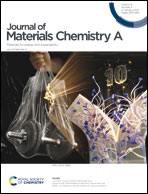New approaches to three-dimensional positive electrodes enabling scalable high areal capacity†
Abstract
Optimizing electrode architecture to enhance areal capacity is key to enabling greater capacity in batteries. Unfortunately, the cost and manufacturing techniques associated with innovative electrode designs have constrained their application. In situ powder infiltration is applied to integrate LiFePO4 nanoparticles (LFP NPs) into highly porous aluminum networks (pAlN) in novel binder-free three-dimensional positive electrodes. The substrate assembled from porous Al wool and foams provides a continuous conductive skeleton. Combined in situ powder infiltration and solution impregnation enables direct anchoring of LFP onto the network, avoiding electrochemically inactive binder additives, whilst achieving excellent mechanical properties, high active material mass loading and good electronic/ionic conductivity. Due to the exquisite interface contact, the formed LFP/pAlN positive electrode exhibits superior areal capacity (6.56 mA h cm−2 at 0.55 mA cm−2) and capacity retention (94.1%, at 2.32 mA cm−2 for 100 cycles). The new electrode structures maximize the functionality of available electrode materials, facilitating the integration of future chemistries into cost-effective and scalable devices.



 Please wait while we load your content...
Please wait while we load your content...